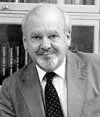About H.G. Williams-Ashman

Director of Research, 1964-1969
As outlined below, a second laboratory was established in the Brady and Basic Science buildings at Hopkins. This was very active and productive under Guy Williams-Ashman but was gradually phased out after his return to the University of Chicago and when Donald Coffey elected to step down as head of it and become director of the Brady Research Laboratories in 1972.
For nearly five years beginning in the summer of 1964, Howard "Guy" Williams-Ashman held professional appointments in the Division of Urology of the Department of Surgery, and in the Department of Pharmacology and Experimental Therapeutics. Paul Talalay and William Scott were instrumental in arranging this joint appointment. Williams- Ashman was trained in biochemistry at the Universities of Cambridge and London, in England. From 1950 to 1964, he had served jointly on the faculty of the Ben May Laboratory for Cancer Research (under the directorship of Charles B. Huggins), and the Department of Biochemistry at the University of Chicago. The investigations of Williams-Ashman and his coworkers at Hopkins concerned various aspects of the biochemistry and physiology of the male reproductive tract and mechanisms of hormone action. These studies were carried out in two separate research facilities only a few minutes walk away from each other. The first of these was a spacious laboratory in the Department of Pharmacology and Experimental Therapeutics, located on the third floor of the Basic Science building; the second was a suite of four ultramodern laboratories that was fashioned out of a set of rooms at the north end of the fifth floor of the Brady building which previously housed sleeping quarters for on-call urology residents. The new Brady Laboratory for Reproductive Biology was built with the aid of generous donations from private sources to Dr. Scott, the largest donor being Donaldson Brown. Scott had engaged the services of an excellent architect and construction firm and their speedy efforts enabled the facility to be occupied in 1965. These new laboratories complemented the Brady Research Laboratories on the floor above and in the basement where Charles Tesar, Bill Scott, Horst Schirmer and several urology residents carried out their experimental work.
The staff of Williams-Ashman's group was mainly comprised of a series of postdoctoral research associates who had applied from many institutions in the United States and abroad to work with him. Some of these colleagues were senior scientists who came to Hopkins on sabbatical, while others had only quite recently received their M.D. or Ph.D. degrees. In addition, two urology residents spent a year of full-time research in this group, and one pediatrician on the Hopkins staff (Dr. Paul Leitman, who later became Chief of the Division of Clinical Pharmacology and Wellcome Professor) undertook experimental studies for the Ph.D. degree. Several highly competent technicians contributed to the research. Of outstanding importance to the operations was the association with Williams-Ashman of Donald S. Coffey who had completed his Ph.D. in 1964. His association with the Williams-Ashman group while he was assistant professor of pharmacology and experimental therapeutics was extremely important and set the foundation for his future research in Brady.
The principal research advances made by Williams-Ashman and his coworkers over the five year period from 1964 to 1969 were polyamine metabolism in the prostate gland and other mammalian organs; deoxyribonucleic acid synthesis in testis and prostate; hormonal regulation of protein synthesis; mechanisms of semen coagulation; studies on male accessory genital gland metabolism, including fructose and nucleotide.
We conclude this brief biographical narrative of Williams-Ashman's five years at Hopkins with a quotation from a letter Guy wrote to Bill Scott:
As time goes on, I realize more and more how extraordinarily lucky I was to have been provided by you with such lavish facilities, unconditional support and freedom to work on whatever struck my fancy throughout the time I was at Hopkins. I was also truly fortunate to have had such excellent young coworkers. I am unashamedly proud that Don Coffey, Larry Ewing, Tony Pegg, Paul Lietman, Haridara Reddi, Angelo Notides, Jun Shimazaki, and Dean Lockwoodhave long since attained full professorships or equivalent posts (Reddi is now chief of a labororatory at NIH), and that the urology residents, Bernie Kosto and Rainer Engel, have developed into distinguished surgeons. And I shall always remember how nice it was to have Bill, Jr., working in the laboratory. As Charles Huggins has said 'the best way to be successful in research is to have young collaborators who are smarter than oneself.' I am particularly happy that Don Coffey has not only established for himself a most prestigious international reputation but has also made the Brady Laboratory for Reproductive Biology into such a flourishing enterprise which is now making so many important clinical as well as basic scientific advances. My only regret regarding my time in the Brady was that I was unable to produce any great clinical significance: but that is Kismet.
